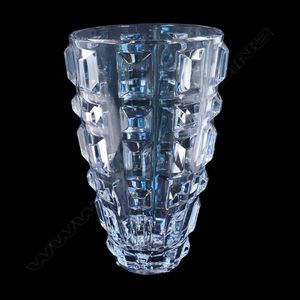Modernist Lead Crystal Vase with Raised Panels
A Rogaska tall lead crystal modernist vase, tapered cylindrical form with raised square and rectangular alternating panels. etched mark to the base, height 30 cm.
You must be a subscriber, and be logged in to view price and dealer details.
Subscribe Now to view actual auction price for this item
When you subscribe, you have the option of setting the currency in which to display prices to $Au, $US, $NZ or Stg.
This item has been sold, and the description, image and price are for reference purposes only.
- Etched - Glass decorated with an etched design, which is achieved through marking out the pattern, protecting the area that is not be etched, and then immersing the object in acid to dissolve the surface of the unprotected area. With some glass objects, such as cameo glass, there may be several layers of different coloured glass, and part of the top layer is dissolved leaving the bottom layer as the background. The longer the time of exposure of the object to acid, the deeper the etching.
The word etching is also sometimes used to describe another method of decoration, where wheel grinders were used decorate the surface, but this technique is usually known as engraving. - Modernism / Modernist - Modernist furniture and design emerged in the early to mid-20th century as a response to traditional styles of the 19th century and prior times, and a reflection of the technological and social changes of the time. Characteristics of Modernist furniture and design include simplicity and minimalism and clean lines and a lack of unnecessary ornamentation are key features. That form follows function is a fundamental principle of Modernist design, and furniture and objects are designed with a focus on their practical use.
Modernist furniture often incorporates geometric shapes, such as cubes, rectangles, and circles. This reflects a departure from the more ornate and curvilinear forms of previous design styles. The furniture often prioritizes ergonomic design, ensuring that objects are comfortable and user-friendly. Modernist designers aimed to create designs that could be mass-produced, making good design accessible to a broader population.
Prominent figures associated with Modernist furniture and object design include designers such as Hans Wegner, Verner Panton, Florence Knoll, Harry Bertoia and Ettore Sottsass - Lead Crystal - The first clear glass, called cristallo was invented during the 15th century in Venice. Prior to this the glass had a slight yellow or greenish colour as a result of iron ore impurities with the glass. 'Cristallo' was heavily exported .
In 1675, while attempting to counter the Venetian dominance of the glass market, British glassmaker George Ravenscroft invented lead glass, by adding lead oxide to to replace the calcium content in glass.
The new glass he created was quicker to melt, and stayed moulten longer, making it easier to work. More importantly, it had a higher refractive index, adding to its brilliance and beauty, especially when embellished with wheel cut decoration.
Lead crystal, is variety of lead glass, with a higher percentage of lead oxide than lead glass.
Ravenscroft's patent on lead crystal expired in 1681, and more glass makers were able to take advantage of his invention. The expansion in production resulted in England to overtaking Venice as the centre of the glass industry in the eighteenth and nineteenth centuries.
This item has been included into following indexes:
